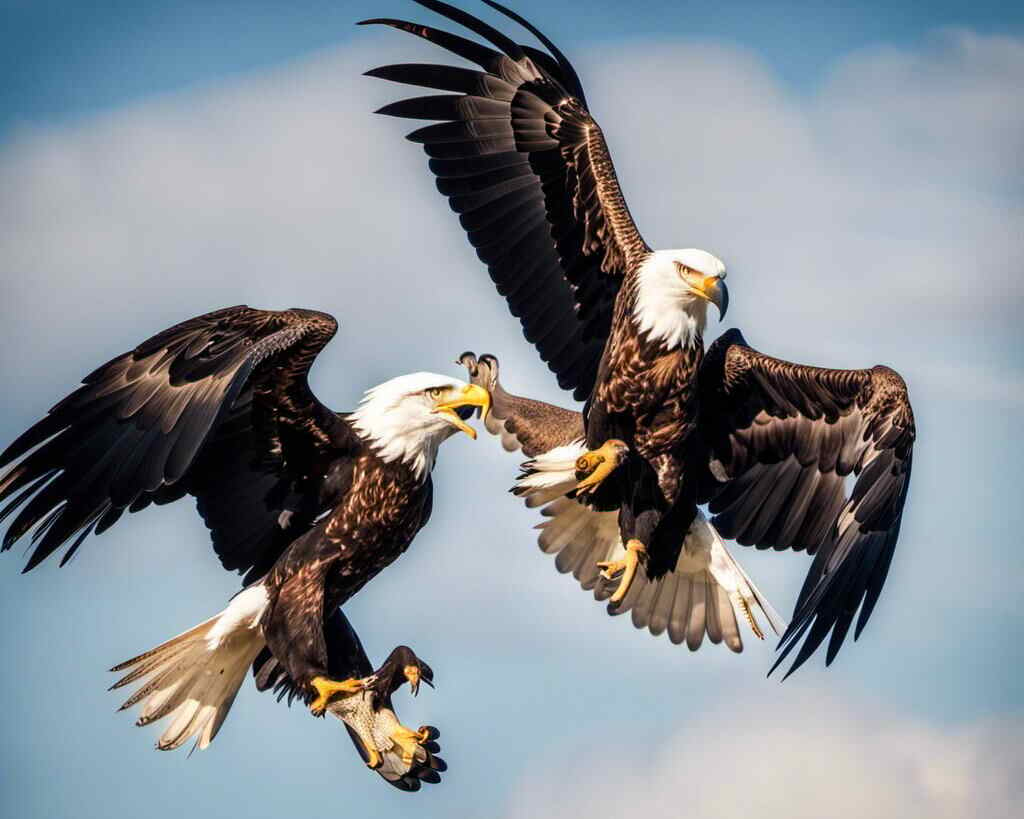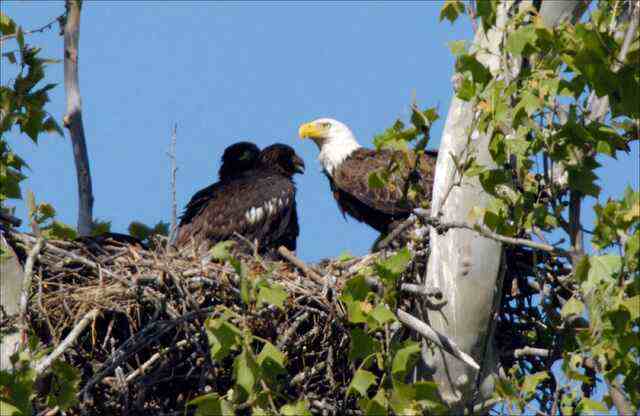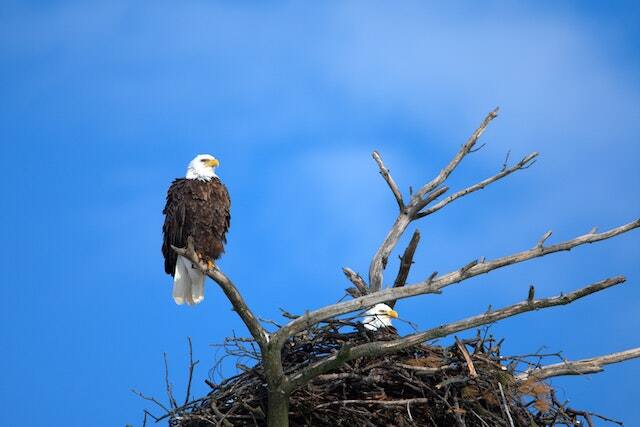Amidst Wisconsin’s stunning landscapes, the awe-inspiring eagle takes flight, symbolizing freedom and resilience. Discover the enigmatic world of eagle mating, their conservation, and the best places to witness their courtship rituals. Uncover the secrets of when eagles mate in Wisconsin.
Table of Contents
- 1 Key Takeaways
- 2 When Do Eagles Mate In Wisconsin
- 3 The Life Cycle of Eagles
- 4 Overview of Eagle Species in Wisconsin
- 5 Anatomy and Physical Characteristics of Eagles
- 6 The Importance of Mating Season for Eagles
- 7 Mating Habits and Rituals of Eagles
- 8 Nesting and Courtship Behaviors
- 9 Understanding Eagle Mating Calls
- 10 Factors Influencing Eagle Mating Season in Wisconsin
- 11 Conservation Efforts to Protect Eagle Populations
- 12 Best Places to Spot Eagles during Mating Season in Wisconsin
- 13 Tips for Observing and Photographing Eagles during Mating Season
- 14 Conclusion
- 15 Frequently Asked Questions
- 15.1 What is the average lifespan of an eagle?
- 15.2 How many eggs does an eagle typically lay during mating season?
- 15.3 How long does the mating season typically last for eagles in Wisconsin?
- 15.4 Do eagles mate for life?
- 15.5 What are some common threats to eagle populations during mating season in Wisconsin?
- 16 Author
Key Takeaways
- Eagle mating season in Wisconsin occurs from January to March.
- Climate change and habitat loss are contributing to the decline in eagle populations in Wisconsin.
- Courtship behaviors, such as displays, synchronized flying, and nest building, are crucial for pair bonding and successful reproduction.
- Monitoring programs and conservation efforts are important for protecting eagle populations in Wisconsin.
When Do Eagles Mate In Wisconsin
Eagles in Wisconsin typically mate during winter or early spring. Nest building and courtship behaviors start as early as January, with eggs laid in January to March.
The Life Cycle of Eagles
The life cycle of eagles in Wisconsin includes a specific mating season. Bald eagles, the most common species of eagles in Wisconsin, typically mate between January and March.
During this time, eagle migration patterns play a significant role in their mating behavior.
Many eagles in Wisconsin migrate to the southern states during the winter and return to their breeding grounds in early spring.
Once back in Wisconsin, eagles engage in courtship displays and aerial acrobatics to attract a mate.
After mating, the female eagle will lay one to three eggs, which both parents will take turns incubating for about 35 days.
Eagle parenting behaviors are highly involved, with both parents taking turns hunting for food and caring for the young eaglets.
These behaviors ensure the survival and growth of the eagle population in Wisconsin.
Moving forward to the overview of eagle species in Wisconsin, it is important to understand the mating habits and behaviors of eagles.
Overview of Eagle Species in Wisconsin
Eagle species found in Wisconsin exhibit a diverse range of physical characteristics and ecological adaptations, captivating the attention of wildlife enthusiasts across the state. The state is home to three eagle species: the Bald Eagle, and the Golden Eagle.
The eagle population in Wisconsin has experienced a decline in recent years, primarily due to habitat loss and human activities.
Climate change also poses a significant threat to eagle populations, as it affects their prey availability and nesting habitats.
Rising temperatures and changes in precipitation patterns can lead to a decrease in fish populations, which are a crucial food source for eagles.
Additionally, extreme weather events such as storms and flooding can destroy eagle nests, further impacting their reproduction and survival.
Understanding the impact of climate change on eagles is essential for conservation efforts in Wisconsin.
Transitioning into the subsequent section about anatomy and physical characteristics of eagles, it is crucial to examine how these adaptations contribute to their survival.
Anatomy and Physical Characteristics of Eagles
An examination of the anatomy and physical characteristics of eagles reveals remarkable adaptations that contribute to their survival in various environments.
Eagles, like other birds of prey, have sharp, curved beaks that are perfectly adapted for tearing flesh and capturing prey.
Their large, powerful wings allow them to soar high in the sky, utilizing thermals to conserve energy while hunting.
Additionally, eagles have strong talons with sharp, curved claws that enable them to grasp and carry their prey with ease.
In terms of reproductive anatomy, male and female eagles have similar external features. However, females tend to be larger than males.
This size difference may be advantageous during mating, as larger females can defend their nests more effectively.
During the breeding season, eagles engage in elaborate courtship displays, which involve aerial acrobatics and vocalizations.
These behaviors are crucial for pair bonding and mate selection.
Transitioning into the subsequent section, the importance of mating season for eagles becomes evident as it is a critical period for pair formation and successful reproduction.
The Importance of Mating Season for Eagles
During the critical period of mating season, eagles engage in elaborate courtship displays, showcasing their impressive aerial acrobatics and vocalizations, which are essential for pair bonding and mate selection.
These behaviors include soaring high in the sky, performing intricate flight patterns, and emitting distinctive calls to attract potential mates.
Eagles often engage in a series of specific rituals, such as synchronized flying and talon grappling, which further strengthen the bond between partners.
The timing of the mating season is crucial for eagles, as it ensures successful reproduction and the survival of their species.
However, climate change has been observed to impact eagle mating patterns, potentially altering the timing and duration of the breeding season.
Understanding and monitoring these behaviors and the impact of climate change is vital for the conservation of eagles and their habitats.
Transitioning into the subsequent section about ‘mating habits and rituals of eagles’, these behaviors provide insight into the complex nature of eagle courtship.
Mating Habits and Rituals of Eagles
The intricate courtship displays of eagles during the mating season, such as synchronized flying and talon grappling, provide a captivating visual representation of their complex mating habits and rituals.
These behaviors serve various purposes, including attracting potential mates and establishing dominance within a pair bond.
Understanding the mating rituals and reproductive behaviors of eagles is crucial for conservation efforts and ensuring their continued survival.
- Elaborate aerial displays: Eagles engage in impressive aerial maneuvers, including swooping, diving, and cartwheeling, to demonstrate their agility and strength.
- Vocalizations: Eagles produce a range of calls during courtship, including high-pitched whistles and melodious trills, which serve as territorial advertisements and bonding signals.
- Gift exchanges: Male eagles often present their prospective mates with symbolic offerings, such as twigs or fish, symbolizing their ability to provide for the female and potential offspring.
- Ritualized bonding behaviors: Eagles engage in intricate talon grappling, where they lock talons mid-air and spiral downwards, strengthening the pair bond and establishing trust.
These captivating mating rituals seamlessly transition into nesting and courtship behaviors, further highlighting the eagles’ commitment to reproduction and family life.
Nesting and Courtship Behaviors
Nesting and courtship behaviors of eagles are characterized by highly intricate and meticulously orchestrated displays of devotion and commitment, showcasing their unwavering dedication to the continuation of their species.
Eagles engage in elaborate pair bonding rituals, strengthening their connection and ensuring successful reproduction.
Nest building is a crucial aspect of their courtship behavior, as it serves as a foundation for their future offspring.
Eagles construct large nests using sticks, twigs, and other materials, often adding soft lining such as grass or moss.
These nests are typically built high up in trees or on cliff ledges to provide protection and a vantage point for hunting. The table below provides a glimpse into the fascinating courtship behaviors of eagles:
| Behavior | Description |
|---|---|
| Ritualized displays | Intricate movements and postures displayed by both male and female eagles |
| Gift exchange | Offering of food or nesting material by the male to the female |
| Sky dancing | Aerial displays involving acrobatic flights and synchronized movements |
Understanding eagle mating calls is the next step in comprehending their reproductive behaviors.
Understanding Eagle Mating Calls
Eagle mating calls can be studied to gain insight into the intricacies of their reproductive behaviors. During the mating season, eagles engage in complex communication to attract mates and establish territories.
Mating calls serve as a crucial aspect of this communication, allowing eagles to signal their presence, advertise their fitness, and attract potential partners.
These vocalizations are characterized by their high-pitched and piercing nature, which can carry over long distances. By analyzing the structure, pitch, and timing of these calls, researchers can decipher information about the age, sex, and overall health of the calling eagle.
Additionally, studying eagle mating calls provides valuable information about the dynamics of pair bonding and courtship rituals.
Understanding these vocalizations can contribute to our knowledge of eagle mating behavior and shed light on the factors influencing their reproductive success.
With this understanding, we can now explore the various factors that influence the eagle mating season in Wisconsin.
Factors Influencing Eagle Mating Season in Wisconsin
One key determinant of successful reproduction in eagles in Wisconsin is the interaction between environmental factors and the availability of suitable nesting sites.
Factors affecting breeding success include food availability, habitat quality, and the impact of climate change.
Climate change, in particular, has the potential to significantly affect eagle mating seasons in Wisconsin.
Rising temperatures and changing precipitation patterns can alter the timing of key events in the breeding cycle, such as the availability of prey and the timing of spring migration.
These changes can disrupt the synchrony between eagles’ reproductive behavior and the availability of resources, leading to reduced breeding success.
To better understand and mitigate these impacts, ongoing research is being conducted to monitor eagle populations and assess the long-term effects of climate change on their reproductive success.
Conservation efforts to protect eagle populations are crucial in light of these challenges.
Conservation Efforts to Protect Eagle Populations
The implementation of comprehensive conservation strategies is crucial in safeguarding the populations of eagles in Wisconsin, as their reproductive success is increasingly threatened by factors such as climate change and habitat degradation.
Conservation efforts aimed at protecting eagle populations in Wisconsin include the establishment of protected areas, habitat restoration projects, and monitoring programs.
Protected areas, such as state parks and wildlife refuges, provide safe havens for eagles to nest and raise their young.
Habitat restoration projects focus on restoring and improving eagle nesting sites by enhancing vegetation, providing suitable nesting platforms, and reducing disturbances.
Monitoring programs track eagle populations and breeding success, allowing researchers to identify trends and implement targeted conservation efforts.
These conservation initiatives are essential for maintaining healthy eagle populations in Wisconsin and ensuring their long-term survival.
Moving forward, it is important to identify the best places to spot eagles during mating season in Wisconsin, as this knowledge can inform conservation efforts and support ecotourism initiatives.
Best Places to Spot Eagles during Mating Season in Wisconsin
In the picturesque state of Wisconsin, avid birdwatchers and nature enthusiasts flock to specific locations during the mating season of these majestic creatures to catch a glimpse of their captivating courtship displays.
The best time to spot eagles during mating season in Wisconsin is from late January to early March. During this period, eagles engage in intricate aerial displays, soaring high above their nesting sites and performing impressive courtship rituals.
Some of the ideal locations for eagle spotting include the Wisconsin River, Lake Wisconsin, and the Mississippi River. These areas provide suitable habitat for eagles and offer excellent vantage points for observing their behavior.
With their keen eyesight and powerful cameras, birdwatchers can capture breathtaking images of eagles in mid-air, as they engage in their courtship rituals.
Transitioning into the subsequent section about ‘tips for observing and photographing eagles during mating season,’ enthusiasts can enhance their experience by following a few essential guidelines.
Tips for Observing and Photographing Eagles during Mating Season
During the mating season, Wisconsin offers excellent opportunities for observing and photographing eagles. To maximize your chances of capturing stunning images, it is important to employ effective observing techniques and photography tips. Here are three essential strategies to enhance your experience:
- Choose the right location: Research and identify areas known for eagle activity during mating season, such as the Upper Mississippi River Valley or the Wisconsin River. These regions have a higher concentration of nests and provide ideal vantage points for observation.
- Be patient and observant: Eagles are known for their cautious nature, so it is crucial to remain still and keep a safe distance to avoid disturbing them. Spend time studying their behavior and movements to anticipate their actions and capture captivating shots.
- Use appropriate equipment: Invest in a quality telephoto lens to capture detailed images of eagles in flight or perched on branches. Additionally, consider using a tripod to ensure stability and sharpness in your photographs.
By employing these observing techniques and photography tips, you can make the most of your experience and capture stunning images of eagles during their mating season in Wisconsin.
Conclusion
In conclusion, eagles in Wisconsin engage in mating activities during the winter or early spring months. As early as January, they begin nest building and courtship behaviors, preparing for the upcoming breeding season.
During January to March, female eagles lay their eggs, marking the start of the incubation period. Observing these majestic birds during their mating rituals and nesting stages provides an exciting opportunity for wildlife enthusiasts and birdwatchers in Wisconsin.
Frequently Asked Questions
What is the average lifespan of an eagle?
The average lifespan of an eagle varies depending on the species, with some living up to 30 years or more. Eagles typically have a mating season that lasts several months, during which they engage in courtship rituals and mate.
How many eggs does an eagle typically lay during mating season?
During the mating season, eagles typically lay an average number of 1-3 eggs. These eggs have an incubation period of around 35 days, during which both male and female eagles take turns in caring for them.
How long does the mating season typically last for eagles in Wisconsin?
The mating season for eagles in Wisconsin typically lasts for several months, during which time they engage in various breeding behaviors and courtship rituals. These activities are crucial for pair bonding and successful reproduction.
Do eagles mate for life?
Eagles are known to have monogamous relationships, meaning they mate for life. This behavior is relatively rare among bird species, as most birds exhibit varying degrees of polygamy or promiscuity in their mating behavior.
What are some common threats to eagle populations during mating season in Wisconsin?
During mating season in Wisconsin, common threats to eagle populations include predator control efforts and habitat destruction. These factors have been found to negatively impact eagle populations, leading to a decline in their numbers.







